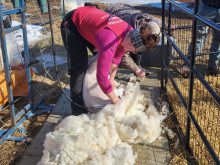MILTON KEYNES, U.K. – The most serious food crisis in British history has resulted in the world’s most thorough animal traceback system.
“We have one of the most robust systems of tracing animals anywhere in the world,” said Archie Sains of the British Meat and Livestock Commission.
Sains works directly with the British Cattle Movement Service, which tracks every bovine in Great Britain with ear tags and passports.
While British farmers have used ear tags since the1950s for tuberculin testing, the passport concept with its added paperwork caused a powerful reaction among farmers.
Read Also

Charges laid after cattle theft
Saskatchewan RCMP lay two charges against a man after six cattle went missing.
“There was some cursing and the second word was ‘off,’ ” said Eddie Gillander of the ANM Group, Europe’s largest auction market located near Aberdeen.
For Scottish cattle finisher Peter McKinnon, the paperwork is a frustrating but necessary cost of doing business as he checks ear tags and matches them to passports.
“I bought 70 cattle down at Sterling and it took me four hours to do the paperwork and another four hours to check the cattle. Some days I’m thoroughly pissed off with it.”
The industry has no choice, said Sains. “The industry has fought it, fought it, fought it. We don’t think they have any option.”
The government launched its computerized cattle tracing system in 1998. It records all ear tag and passport numbers and knows where all cattle are all the time.
The passport, provided free of charge, resembles a 30 page chequebook.
It records the farm number, dam’s registration number and calf number.
Anytime the animal moves, that activity is recorded on a single page which is submitted to the cattle movement service by mail or electronically.
There is no margin for error or carelessness.
If an animal has no identification, it cannot be sold.
If a farmer does not comply, the government can check his subsidy applications and payments are forfeited.
Tagging must take place within 36 hours of birth for dairy calves and 14 days for beef calves. Registration forms must be filed immediately.
Tags are purchased from farm supply stores which provide the farmer with a set of eligible numbers that are be recorded by the cattle movement service.
A tag costs 50 pence to £1.20. Each animal must have a double tag attached to the front and back of the ear.
The tags are yellow and must be a minimum of 45 x 55 millimetres according to European Union rules.
All pieces include the initials UK and a 13 digit number that can be read at a distance.
When the tag is applied, the passport is started, recording every place individual cattle have traveled throughout their lives.
Under this system an animal can be tracked from birth to slaughter. The abattoirs record lot numbers and if necessary can trace back to a farm based on which animals were slaughtered on a particular day.
Britain is lobbying to have this system implemented throughout Europe.
Even with this system, international markets are nearly impenetrable.
Britain can export boneless beef to countries where the ban has been lifted.
This includes the Falkland Islands, Cyprus and Malta.
In reality, no meat or live animals are leaving the country, said Sains.
The abattoir must have full EU approval and must have an efficient computerized system for traceability. This is not possible for some.
“The key beef-exporting abattoirs were exporting predominantly cow beef,” said Sains.
One plant was slaughtering1,000 cows per day and went bankrupt.
“It was a superb operation. It has died overnight,” he said.

















